-
Posts
29278 -
Joined
-
Days Won
38
Content Type
Profiles
Forums
Gallery
Events
Posts posted by Steph
-
-
Champ (Darla's)
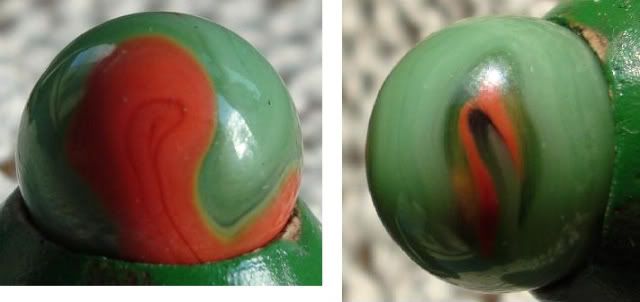
-
Interesting, that looks Jabo to me.....
Would probably look Jabo to most.
and yet it isn't.
-
Cairo novelty:

-
Some of the mistakes in the obituary would be him "acquiring" factories in Sistersville and Ottawa by 1922 -- when he was only 22.
Berry Pink did have something to do with the Alley company shortly after Lawrence Alley started it, sometime around 1930. But supposedly Alley made his own marble machine and Pink wasn't listed as a partner on a 1930 deed for the Sistersville property used by "The Lawrence Glass Novelty Company" as it was officially known then.
Pink had sort of a pretentious reputation in Sistersville. Stayed at a fancy hotel when he came in from New York and wouldn't drink the local water. And then he seems to have left under a legal cloud, something about problems with a marble packaging machine.
He had a relationship with the Peltier company in Ottawa in the 1930's, but in 1922?
One might think the 1922 date is simply a typo, except that it is coupled with the implication that a marble-making machine "perfected" by Pink was responsible for replacing clay marbles in the marketplace.
While there may be something to explore about the relative expense of clays and glass marbles and what role Berry Pink might have had in promoting glass marbles, glass marble making had already been automated by the first time Pink is on any well-known record as being involved with the marble industry.
Will he someday be revealed to have some role in, say, helping William Miller perfect his machine in the 20's? Or helping John Early work out the kinks in the Akro machinery? Or Howard Jenkins at Christensen Agate? Well, anyway, we know Pink was only 2 when Martin Christensen started it all rolling at MFC.
There are other questionable points. Finishing at Princeton before starting his naval career ... at age 17?
What about those numbers? Was a billion marbles a year possible with the technology of the 50's? Did he really spend $55,000 a year for the tournaments?
The clouded details in 1962 make the 1941 article all the more interesting. Four years of history would be harder to distort in a material way. So what is the truth about the factory he acquired in 37 or so? and how he converted his recycled glass to marbles?
-
LOL. That wasn't such a bad name. lolol
I also have a lot of other tournament-related articles from other years, so much that I can't post it all. So I've been trying to let it gel, thinking about a good way to organize it. I'm an information addict. I hadn't been on any binges in a while, but Don's Berry Pink trophy knocked me right off the wagon.
So anyway ... the New York Times archives are free up through 1922. I'm hoping that just maybe the 1923 articles might be free next year. I was tempted to pay for some of them but I think I can at least wait until January, just in case they do become free. It would be neat to see articles from the first year the National Marbles Tournament was run. The 1923 articles might even fill in some of the blanks I'm missing from the 1922 story. Folks do like the occasional human interest recap, you know.
Here's a pair of stories I have from 1926 -- with some serious human interest stuff built in. In 1926, if Danny Gore won the tournament his city was going to pay for him to go to college. AND he had his lucky shooter stolen. But he managed to win his semi-final without it.
The shooter was found in time for the final but ....
(click for larger/expanded versions of the articles)
Notice what the prizes were. There were trophies, if that is what was meant by "silver cups", but they didn't go to any of the winners. First and 2nd place and the "league winners" all got watches. And the champ also got baseball tickets.
That's sort of how it was in 1922 also. There were trophies at different levels, and at least one medal. And the winner of the game which might not have happened was supposed to get a gold watch.
A gold watch was at least one of the prizes the big winner got in 1925.
-
I think you're right! Thanks! I'll go fix that now. :-)
-
One reason it is interesting to see something as early as 1941 is that by 1962 there were significant errors in the history. Oh my goodness is that wrong in some places.
(click link below for larger version, might have to doubleclick for full size)
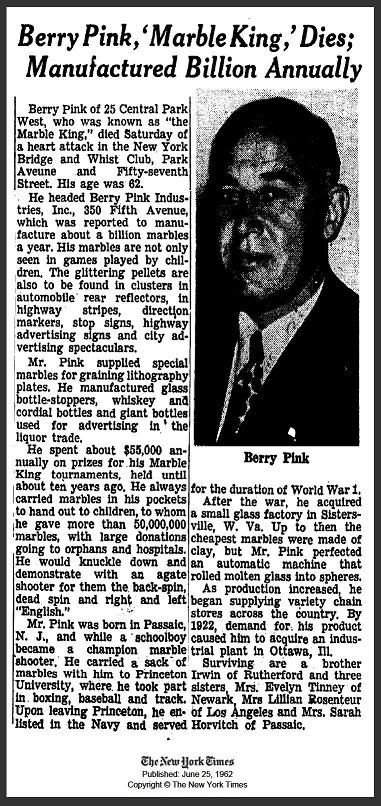
http://i119.photobucket.com/albums/o151/modularforms/History/1962_BerryPinkObituary_NYT.jpg
-
Here's what appears to be a "press release" type article dated Jan. 28, 1941 about Berry Pink from when he was in the middle of building his empire.
Interesting to see something from relatively early on. Subject to hype perhaps but still fresh. Still very close to the early events of his career as they were happening. He would have been about 40. The start of the Marble King company was still 8 years away at this time.
(click to enlarge)
(source)
It's hard to read so I've done my best to transcribe it. Not sure I have it all right.
Succeeds in Turning
Refuse Into Gold Mine
Four years ago an American
named Berry Pink took the after-
noon off from his work and strolled
disconsolately through the city. He
was fed up with his work and was
trying desperately to think of some-
thing new to do.
As he walked he noticed refuse, . . . . . . . <---- did I read that correctly?
and idly stood and watched while
they tipped the rubbish into a cart.
He was suprprised to see how many . . . . . . . <---- ?
dirty old milk bottles and fragments . . . . . . . <---- ?
of broken glass tumbled into the
cart and although he soon resumed
his walk, the germ of an idea had
entered his head.
There must be some use to which
all the wasted broken and used glass
in American could be put. And then
he remembered a game he had
played in his youth, and, in a flash
the idea came to him--marbles--
that was the solution.
Now, Berry Pink was what the
Americans call a go-getter. Once
started on an idea he saw it through . . . . . . . <---- ?
--and with a vengeance! In a short
while he had established a factory
and was busy buying up all the old
bottles, cold-cream jars and bits of
glass he could lay his hands on, and
converting them all into marbles.
He also instituted a campaign to . . . . . . . <---- ?
make America thoroughly "marble-
conscious"--and he succeeded be-
yond his wildest dreams.
Today Berry Pink is known all
over America as "The Marbles
King" and, thanks to his efforts,
more than 5,000,000 people in the
U. S. play the game.
The work he was fed up with might have been the one where he was jobbering Peltiers at Rosenthal.
I wonder if the piece did come from Berry Pink Industries as part of the their PR or if it was written by someone on the outside.
" In a short
while he had established a factory
and was busy buying up all the old
bottles, cold-cream jars and bits of
glass he could lay his hands on, and
converting them all into marbles. "
That sounds as if it says that Berry Pink actually made marbles himself in the late 30's. Is it possible?
Is the location of his factory known? Whether it was simply a recycling plant or actually a marble factory, where would it have been?
-
Nice historical note.
... wishing the best for Dave and everyone at Jabo.
-
Anticlimactic postcript:
There is record of Rech playing one more "world championship" match -- in September of '22. He lost, and one Francis Dinkey of West New York was declared the "marble monarch".
September 8
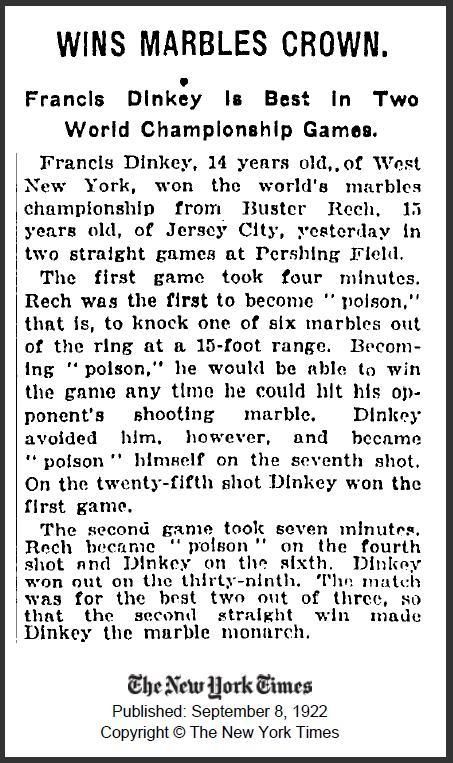
But how did Francis Dinkey come to be in the game? No clue.
-
I thought I had enough articles to tell the whole story, but it was a convoluted story, and it's been a bit since I downloaded them, so now I can't recall.
In any case, now I'm not seeing anything else about Rech or Markoff or Ross competing against each other.
Here it is already July 9, 1922. And then sometime within the next month or so, plans had made for a more formal and better organized tournament the next year, with many cities invited in advance. Perhaps the greater New York plans fell apart.
This is from an article by Armstrong Perry in The American Boy.
BY THIS TIME marble championships where getting to be hot dog all over. Even Bostonhad one. In a match between Washington and Tidewater, Virginia, one newspapermeasured the two contestants like a pair of prize fighters, published the measurementsand said that on account of the shapes of their hands one player would win at "fat" andthe other at "ringers" and it came out just as the paper predicted. The Scripps- McRaeorganization, which has a string of twenty-eight newspapers, called a hundred editorstogether for a conference about this time and they all began to talk about marbles. Beforethey finished they had spent a half a day discussing the game and had decided to organizea national tournament for 1923 to decide whether Buster Rech or Frankie McQuade is thereal national champion or whether the title belongs to some boy in San Francisco, NewOrleans, or elsewhere(Link to PDF of articleat the Jersey City Rotary Club site)Rech and McQuade are mentioned. Rech's New York challengers seem to have evaporated. That sort of makes sense, since Markoff had already lost a tournament to McQuade so he wasn't a contender for the national title. But did he play again?
Pix from the article:
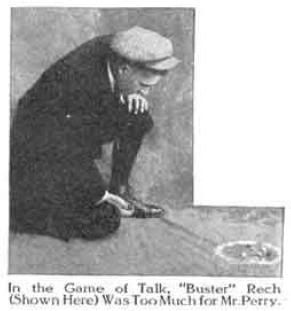
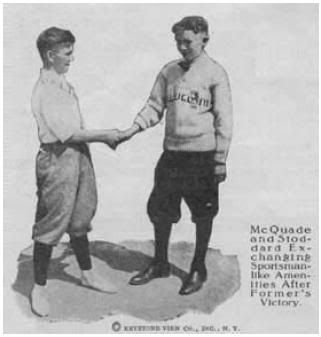
-
But what happened next?!?!?!
-
Just been having fun with the Times archives.
Funny how important marbles were in the 1800's and early 1900's. The Times even imported stories from out of state.
They reported on kids stealing marbles.
On kids being arrested for playing marbles or playing marbles for keeps (in 1909 a judge in Washington declared keeps illegal).
On marbles as gifts. 1884 was the year of the marble. 1885 was the year of the top and marbles "couldn't be given away". But in 1893 a bag of marbles would be welcome, especially if there were several 'reals' in it. Make the bag of duck or coarse linen and embroider the boy's initial on it.
On marbles in a nostalgic way. On marbles in an educational and moralistic way. Rich society women apparently disapproved of marbles in 1909 but they were accused of turning their sons into mollycoddles. Public school boys had more "grit and vigor".
On tournaments.
How Arabian kids played marbles.
On city planning, with parks for kids to play marbles.
Marbles was bigtime.
Oh yes, there was one about collecting marbles -- lol -- this boy had a huge collection of marbles without ever playing a game. He was loaning them and charging interest. Something like giving out 6 marbles and demanding 9 in return.
-
The story goes on!
It is a hard battle but Buster Rech holds on in Jersey. Arrangements are made for him to defend his title in New York. Buster Ross wins in Queens.
July 7
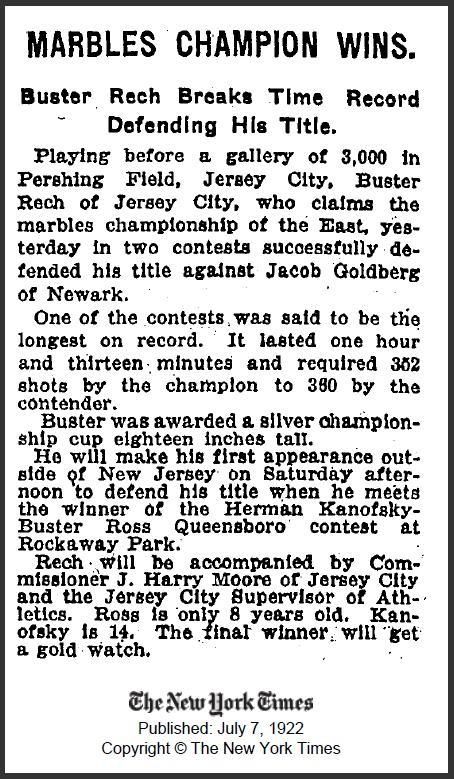
July 9
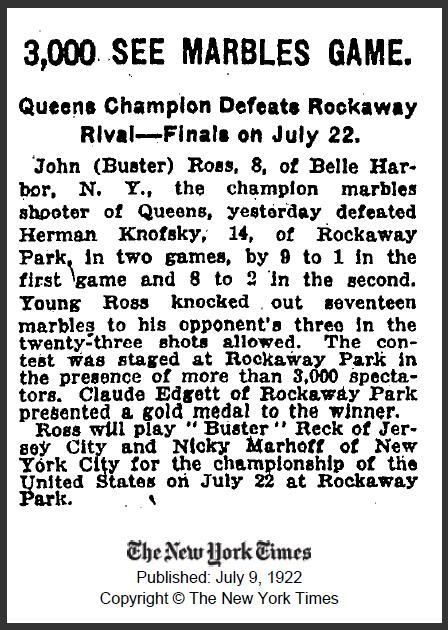
-
Back in the city, the competition heats up. 8-year-old Buster Ross appears to be the sentimental favorite in Queens.
June 25
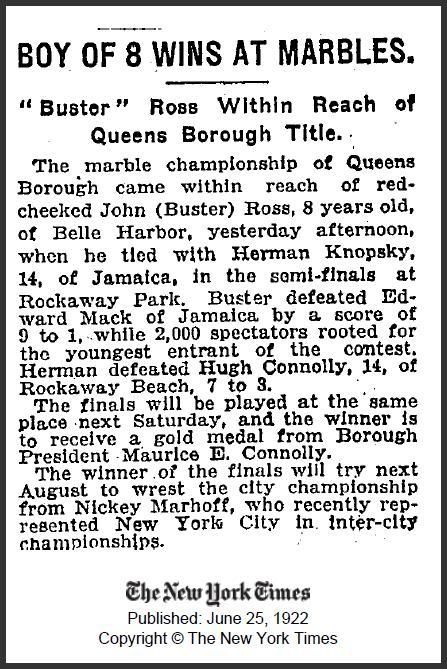
-
The games go on. Or they will when school lets out. A tournament is planned in Queens. The winner will go up against New York City's Nickey Markoff, for the Greater New York championship.
June 11
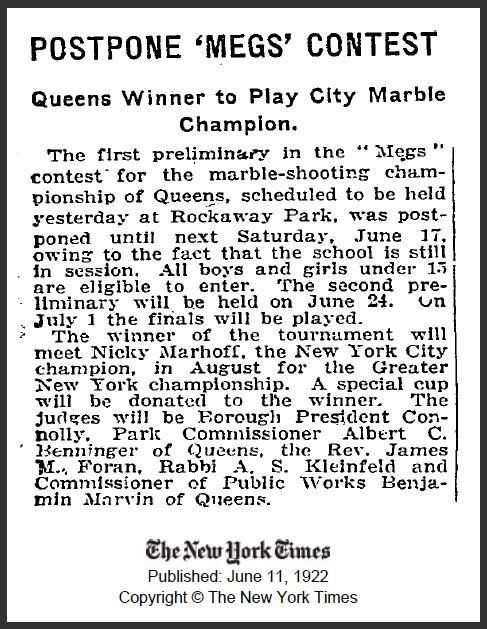
Meanwhile, in New Jersey.
Jacob Goldberg wins the statewide competition while Buster Rech watches. But now Buster will fight again.
June 18
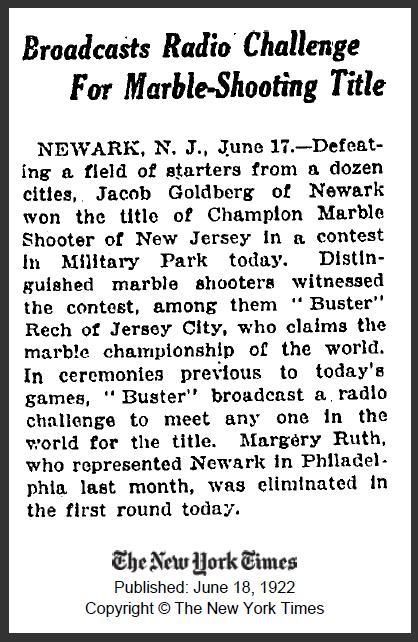
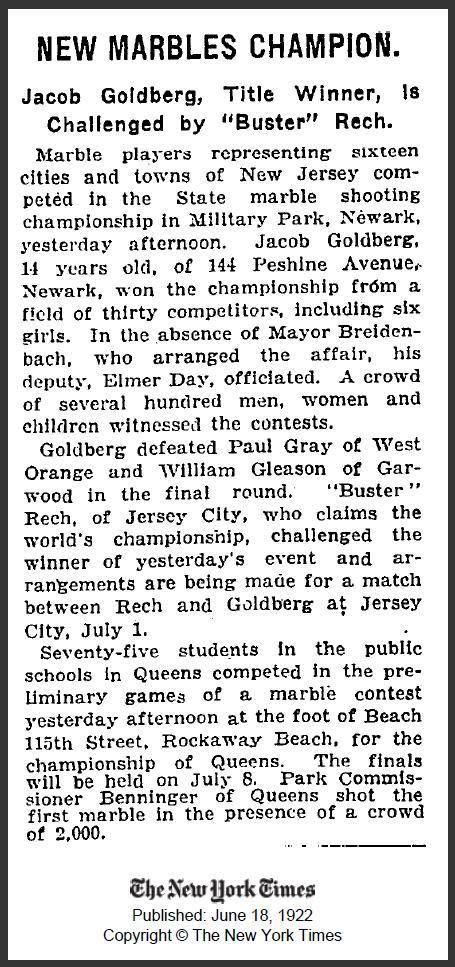
-
-
A new "world championship" tournament was arranged.
This time the players would meet in Philadephia.
Red Stoddard will represent Philadelphia. Frank McQuade plays for Baltimore. Nickey Markoff is the champ of New York City. And Marjorie "Babe" Ruth will play for Newark -- because no boys answered the mayor's call.
But Jersey City is protective of its champion. Why should Buster have to prove himself in Philadelphia? He is already champion of the world. Challengers should come to New Jersey.
If Buster doesn't compete he would just be "the obscure champion of Jersey City", replied the rotary club of Philadelphia.
May 20
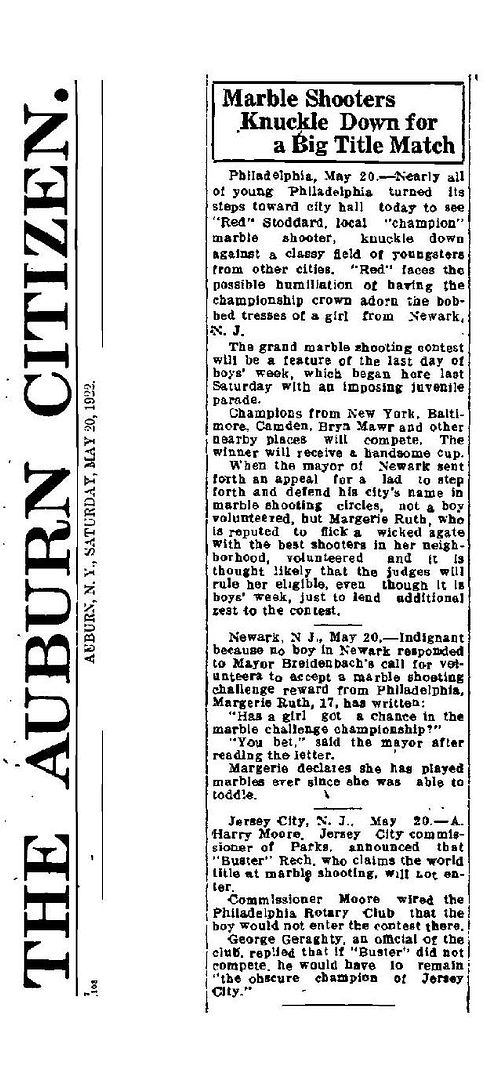

-
Buster's challenge was taken up by Washington D.C. Their champ was Mike Troiano. More stories are told in the Washington Post, but there's a fee for the articles so they'll have to wait. lol (The NY times archives are free from 1851 to 1922.)
May 14

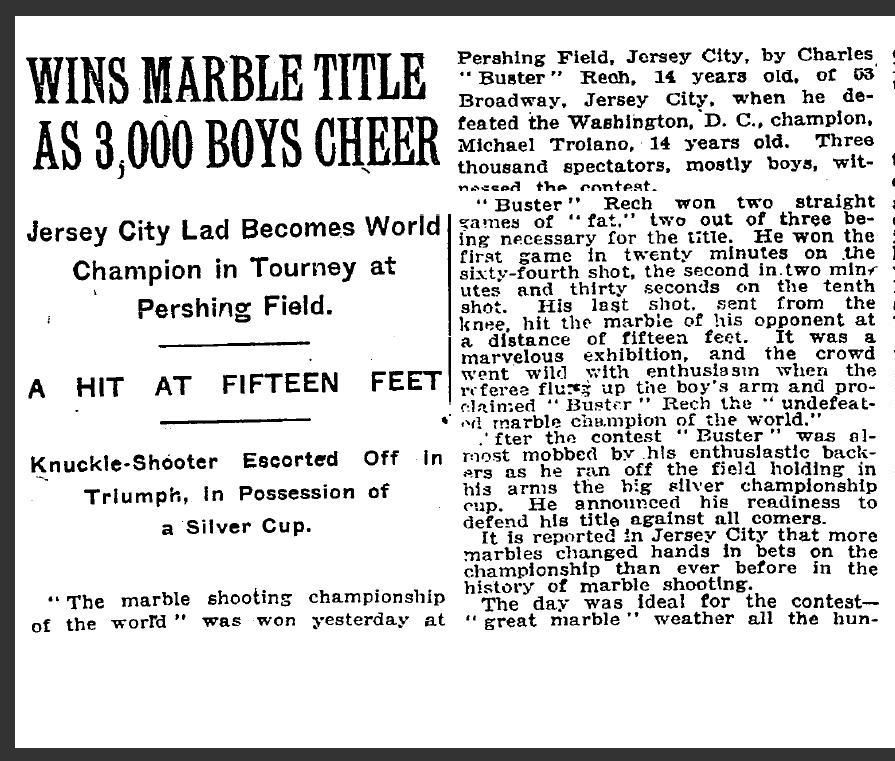
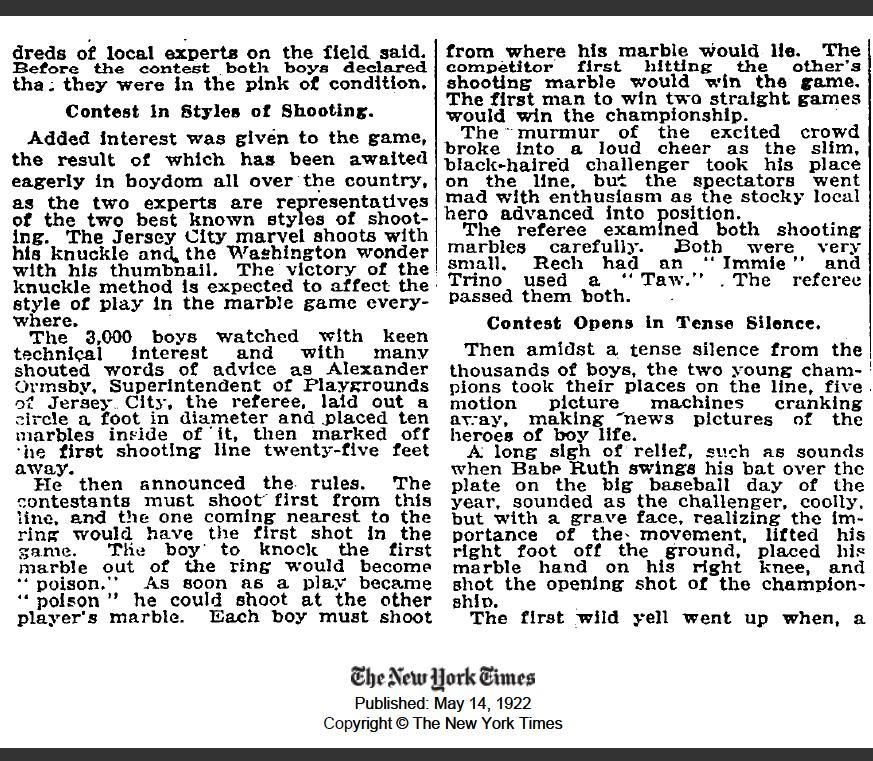
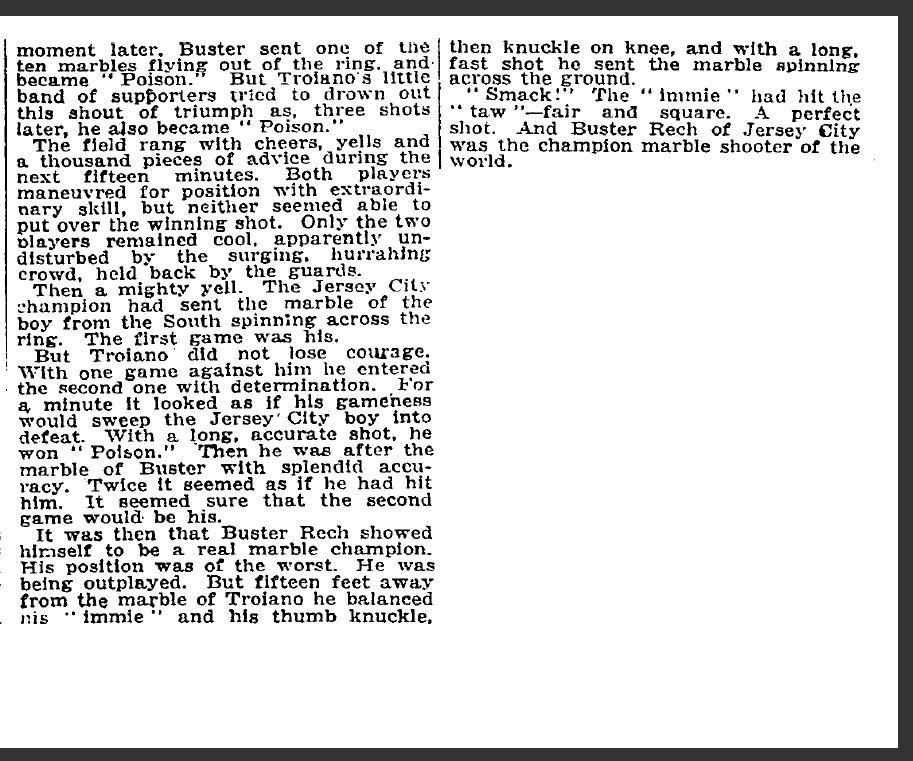
Buster beat Mike. He was now "officially" the world champion. But the excitement wasn't over.
-
The summer of 1922 was very exciting. This is the game which led to the annual national marbles tournament which started in 1923.
April 21
(click to enlarge)
After winning this game in Jersey City, Buster Rech challenged all comers. The drama was reported in the newspapers. It got quite complicated. Rules were being made up as they went. Champs of different cities played different games, so how could they compete fairly to see who was really best?
-
Starting with the humorous one, then in chronological order. Didn't include all the times kids were hit by cars while playing marbles in the street.
1906

1851

1858
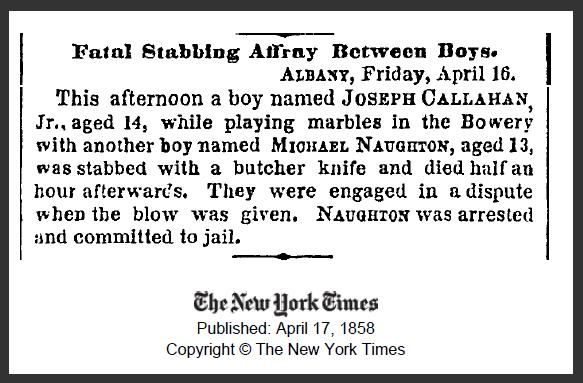
1874
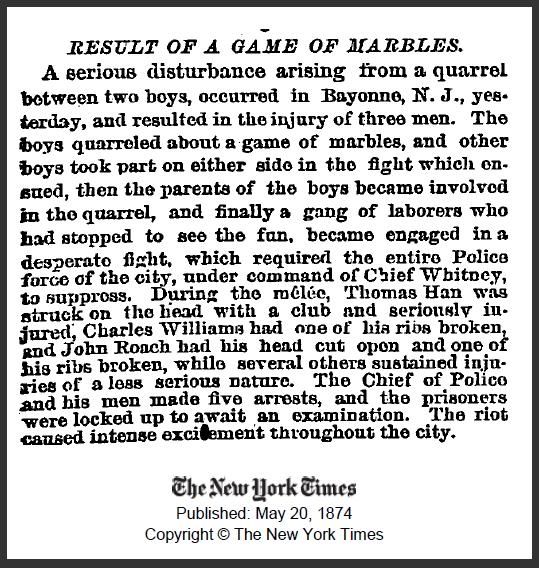
1877
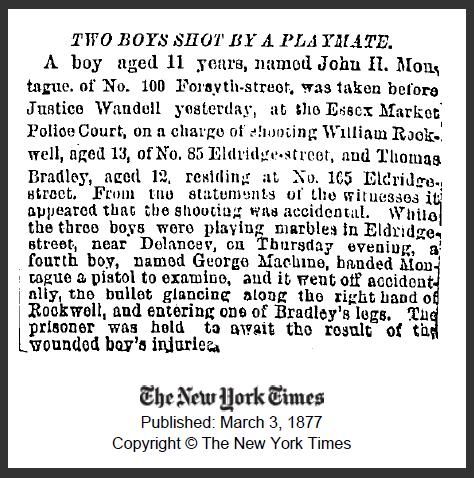
1880
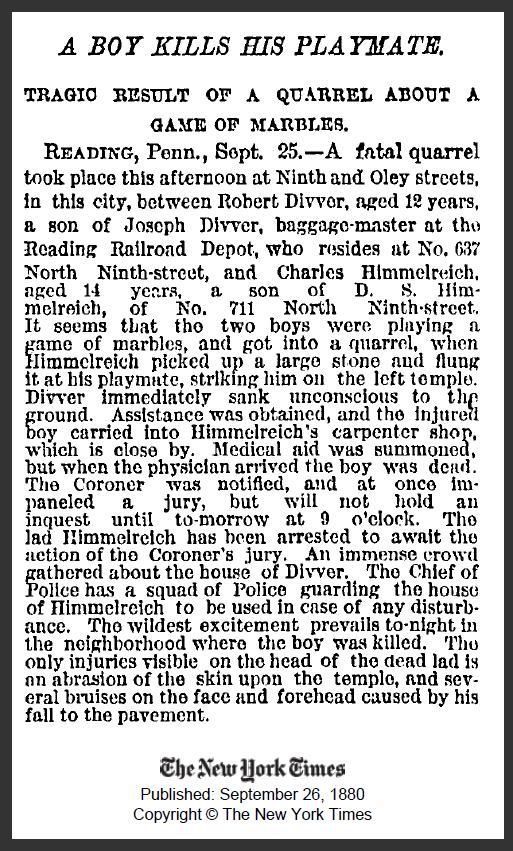
1886

1903
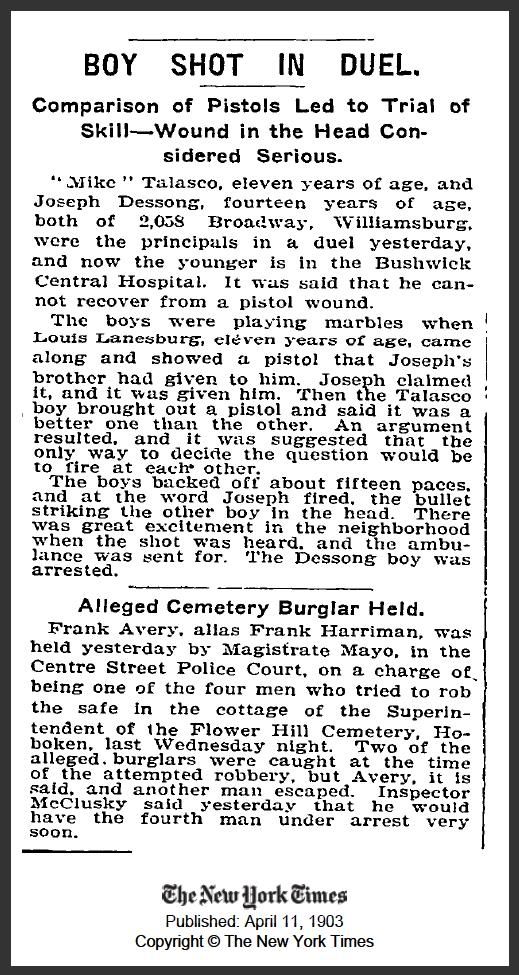
-
 1
1
-
-
Anacortes seemed to have reason for optimism in 1991. A 1990 article had discussed the improvements they were making, new equipment they had ordered.
Then in early 1992, a few months after the following article ran, marble production ceased. They could still have been profitable -- they had enough orders to keep them going -- but according to AMMM, the marble side of the business was negatively impacting the more successful rope making side of the business. So, they stopped making marbles.
ROLLIN', ROLLIN', ROLLIN' ...IN ANACORTES, THEY KEEP THEM AGGIES ROLLIN' ...
By Jon Hahn P-I Columnist
Monday, December 23, 1991
Section: Living, Page: C1
Sullivan & Ryan have got all their marbles, and then some.
And they've set out to corner the U.S. marble market from the Northwest corner of the country, in the top, left-hand corner of Anacortes (population, 11,700).
They've got so many marbles that if you opened the door of their warehouse at the far end of Commercial Street and let their marbles roll south down the main drag, they'd start an avalanche that would wipe out Mount Vernon and Everett before burying the north end of Seattle (population, 518,000).
Sullivan & Ryan run, and in fact, are the Vitro Agate Marble Corp., one of only three big commercial marble makers in the United States. ``We've got maybe 100 million marbles in stock right now," said Jack Ryan, the affable marble mogul who wears the vice-president's hat even though he admits he ``never was very good at marble-shooting."
Which apparently has nothing to do with making marbles. Vitro Agate's furnaces roll out from 300 million to 500 million marbles a year. Many are classic playing marbles and others are decorative, used by floral arrangers or for aquariums.
Ryan and Tim Sullivan, who wears the president's hat, previously were vice-presidents for a corporation that owned Vitro Agate back in Parkersburg, W.Va. Ryan ran the division that included the marble company.
The pair left and formed their own rope company - in competition with their former employer - and sold that when they moved here to open Puget Sound Rope Corp. It is located in the other half of their huge warehouse. Two years ago, they bought the $1 million-a-year marble operation and brought it to Anacortes.
Their translucent ``cat's eye" and ``classic" shooters are in stores up and down the West Coast and across the country. Their industrial marbles have rolled even farther. But not a whole lot of people in town know what goes on inside the big metal warehouse near the docks at the north end of town.
Huge amounts of broken glass - much of it from Puget Sound industrial sources - are mixed with tiny amounts of coloring chemicals, then cooked to a molten orange 2,200 degrees in a pair of gas-fired blast furnaces. The furnaces are only turned off for maintenance twice a year, so they're rolling out marbles 24 hours a day, almost every day.
A constant stream of gravity-fed molten glass pours out through ceramic bushings and is mechanically snipped. The resulting blob is plopped in either of two reciprocating steel funnels, which in turn deposit the marble-in-the-making onto precision-grooved steel rollers. Uniformity tolerances for size and roundness of marbles are down to three places beyond the decimal point.
If the marble needs colored swirls, a bakery decorator-type nozzle dribbles colored goop onto the molten stream just before it's cut into the blob.
As the marble is rolled between the opposing grooved rollers, it is shaped and sized. The twisty-turny path up and down the rollers also twists any colored-glass strands and swirls that were added by the nozzle.
Others get a bonding spray of iridescent coating farther down the line.
Rejects are hand-picked (with tongs) or fall into the reject bin. The others roll into cooling pans. And still others bypass the rounding rollers and, instead, plop directly onto a flat steel surface. These so-called ``nuggets" are big sellers in the decorative and floral trades, as well as for aquariums, etc.
The smaller marbles are allowed to cool in single-layered metal troughs. The larger marbles cool off slowly in buckets overnight, which makes for a sort of natural annealing and stronger marbles.
Of course, something can always go wrong, which argues for constant monitoring, Ryan said. ``If you're changing a ceramic bushing at the bottom of the tank, and the stream gets away from you, watch out! When molten glass begins flowing, it takes on a life of its own."
Knock on wood, because nothing has. Life in the marble factory usually just rolls along, as the millions of mibs get hand-culled, eyeballed and inspected before they're either packed in small, retail-size packages or into 3,000-pound bulk, industrial type hampers.
The quality control process culls out any cracked, discolored, or mismatched marbles, as well as small pieces and any nuggets with sharp edges or protrusions.
A small, but efficient work force shift jobs frequently to avoid production line boredom. They hand pack playing marbles in net bags of 25 or 45, along with one larger ``shooter." Larger packs include 72 playing marbles, with three shooters.
Decorative marbles are packed in 100 and 350-count plastic jars or 1,000-count poly bags.
``Classic" playing marbles look very much like the mibs of our childhood, in 5/8-inch diameter. Small retail packs also include a couple of 7/8-inch ``shooters." There's also a ``tournament grade" 3/4-inch shooter.
Decorative marbles come in two basic sizes, 9/16- and 7/8-inch diameter, in six basic colors (with the iridescent option) and another six custom translucent colors, as well as plain white or black.
Industrial grade marbles come in several sizes and any number of yucky colors.
They usually run those, Ryan explained, when they're purging one color of glass from the furnace and beginning to run another, which results in some pretty strange shades.
Have you heard that little thing banging around when you shake the aerosol paint can? Good chance it's one of Ryan & Sullivan's marbles.
With only two other major players in this country, Ryan & Sullivan get some competition from Mexico - which ``probably accounts for 50 percent of the world marble market" - and from Taiwan, Pakistan, India, Portugal, Turkey and China, according to Ryan.
``Most marbles are casual purchases, but if you see American marbles side by side with imports, there's no comparison ... ours are much better!" he said.
Marbles haven't changed much over the years, but someone's always trying. Ryan noted one recent study in which someone tried to introduce plastic marbles.
``They had a big test group of kids, but the acceptance of plastic marbles was a big zero," he said.
``Marble players want real marbles; they've got to feel `cold' and have a good weight or heft in the hand."
Now who ever heard of a plastic jasper or aggie?
Staff columnist Jon Hahn writes three times a week in the P-I.
cp
This article contained at least one photo or illustration as described below:
Type: Color Photos
Description: MIKE BAINTER/P-I photos -- (1) Vitro Agate co-owner Jack Ryan runs his hands through a 3,000-pound pile of marbles.
(2) A handful of marbles shows the variety of color that rolls out of the manufacturing plant at Vitro Agate in Anacortes.
(3) A marble is born when a blob of molten glass is dropped onto precision-grooved steel rollers that will shape it into a ball.
-
Made in Japan for sale in South America:
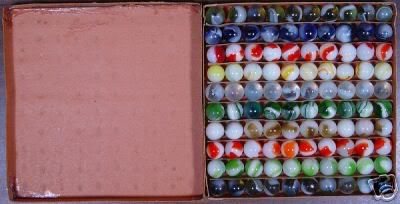

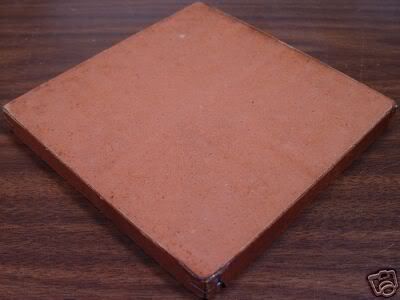
From the auction description:
This lot, A MARBLE CONSIGNMENT, consists of a 100-count marble box (ca. 1930s) with approximate dimensions of 5-3/16" by 5-3/16" by 17/32". The only marking on it is a small side label reading "100 Bolitas/No. 00/Asst. B/Industria/Japonesa," indicating manufacture in Japan and sale in South America, probably Argentina. The marbles all measure about 1/2" (13 mm) and represent eight different color combinations of "Patches" arranged in 10 columns ....(source)
-
Definitely not too early.



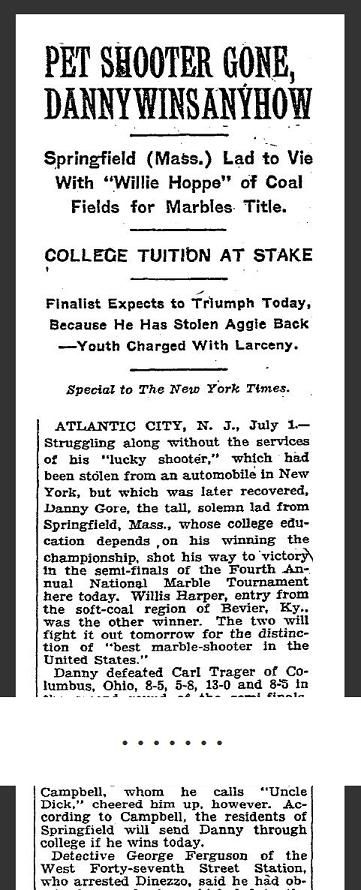

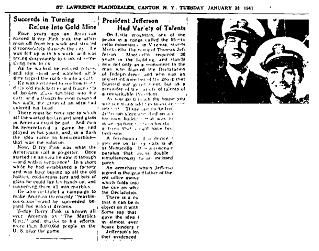
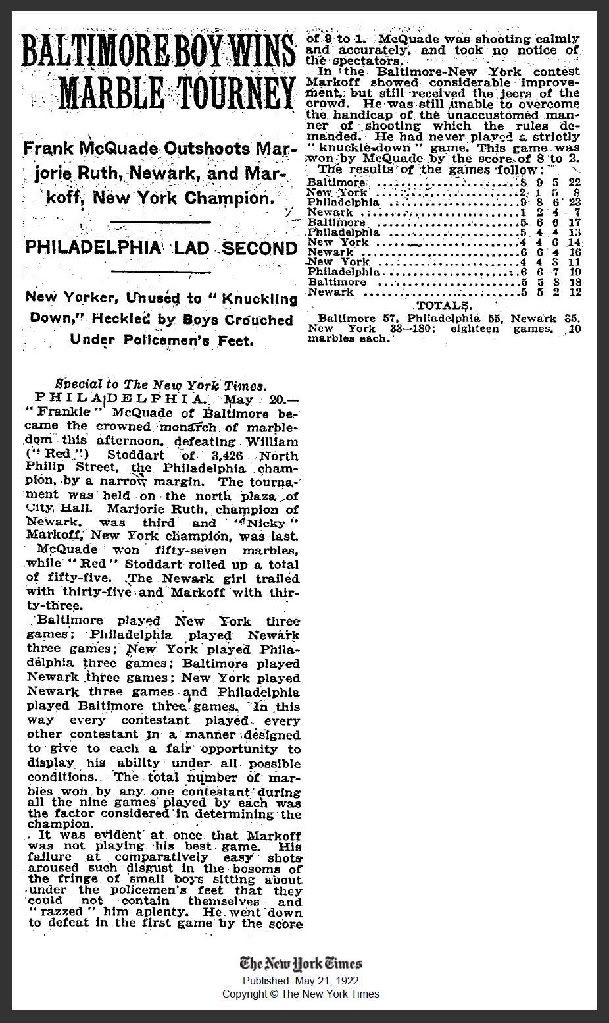
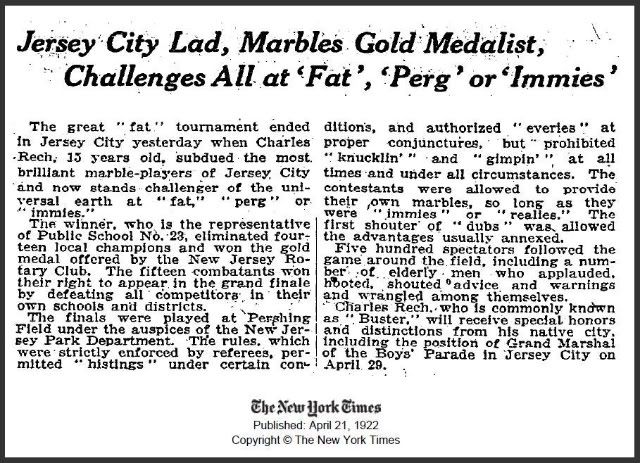
Structure Fun - Ron!?
in General Marble & Glass Chat
Posted
Here's an Alley pistachio and .... ? I don't know what but Alley wouldn't be my first guess.
Yet they look almost identical .... in a way. lol . . . Their ribbon pattern is very much alike.
The triangular loop in front and then a stalk below it and two arms branching out of the stalk.
The arms on the pistachio are different lengths. One is long and loops back toward the base of the marble. The arms on #2 are both long and reach around to the back of the marble where one folds over the other.
They both have a little eye in back. But on mib #2 the eye is a little higher than on the pistachio, so it didn't show up automatically when I did the mostly 90 degree rotations for this series of pix. The odd pic on the top right is a pic of the eye. I borrowed it from another photo series.
(click to enlarge)
The mystery mib has quite a bit of color. At least orange and green and teal and white and clear. Here's another pic which might show colors better. Now I've misplaced the mib so I can't be more precise but take it for granted that my pix wash the colors out.
. . . . .
I don't know why but I totally dig this ribbon pattern.